On Writing Subtext: What It Is & Why It Matters in Storytelling
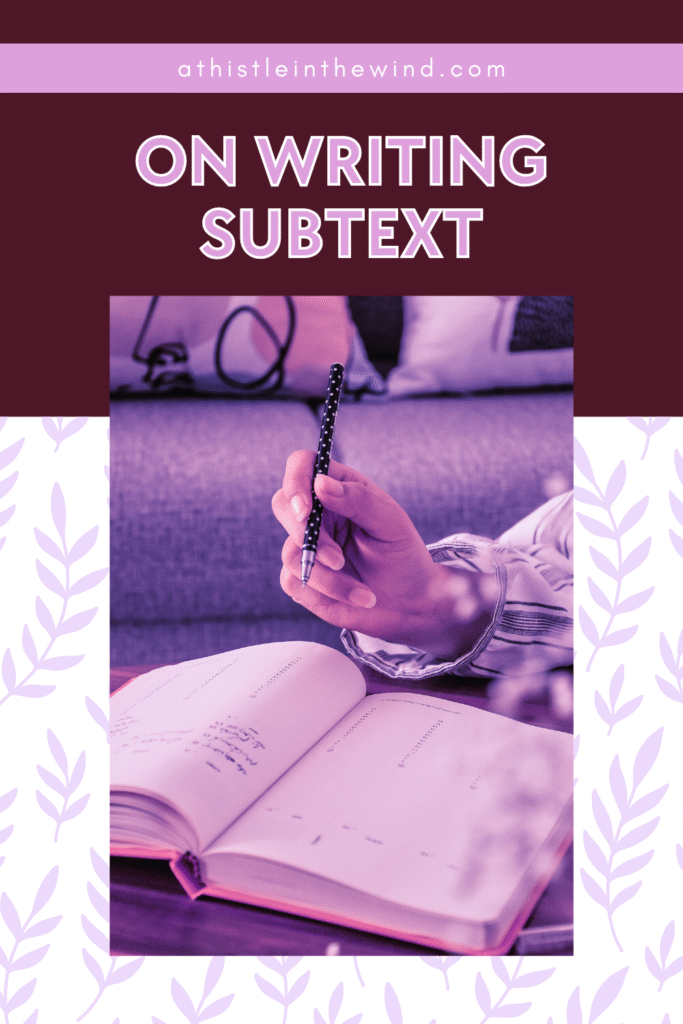
In case you missed it, I just wrapped up my June reading list, and a common denominator in the four great books I read this month was subtext. Seriously, when done right, subtext in writing can be an incredibly powerful tool to make your story seem more alive. If you have no idea what I’m talking about (and that’s totally fine), think of it this way.
Have you ever read a story where characters feel very, very realistic? Where their true feelings and motivations just seemed to simmer beneath the surface?
Well, that’s subtext.
And if you use it correctly, it can do wonders. So, without wasting any time, let’s take a closer look at it.
What is Subtext in Writing?
Since I’ve started reading more contemporary and indie writers, I’ve noticed a lack of understanding of certain literary tools. And while that’s totally fine, it just shows just how much gatekeeping there is in the industry and that’s just not right.
I don’t think you need to have a literature or creative writing degree to write. In fact, some of the best writers in history were not English majors. You think the Bronte sisters went to university for writing? No, writing is a skill you can learn. And the way to do this is by learning and experimenting with different writing techniques.
The Definition of Subtext
A common misconception is that subtext is just what’s left unsaid in dialogue. While that’s partly true, subtext is really about the hidden feelings, motives, and tensions shaping what characters say—and what they avoid saying.
Not every character in your story will be hiding these things. In fact, they don’t have to hide everything. It’s just more about…what’s left unsaid.
One way to think about it is as a combination of two key elements: the text and the context.
- Text refers to the actual words spoken or the actions performed.
- Context is everything surrounding that text.
This includes the external circumstances, the situation, and the relationship dynamics at play that ultimately inform readers more than what you, the writer, are letting on.
Let’s take the line, “as you wish,” from The Princess Bride. The text is a simple, polite phrase, but the context of Wesley’s enduring love for Buttercup transforms it into a subtextual declaration of affection. Similarly, the simple action of “drinking tea” can carry vastly different subtext. It can be conformity, romance, danger, or rebellion; it all depends on the context of the scene.
Types of Subtext in Storytelling
There are many ways subtext shows up in your writing. It can be discussed as:
- Relationship Dynamics: These are the relationships between characters; who holds power, who admires whom, what they truly think of each other and so on. Sometimes, characters aren’t even consciously aware of these underlying dynamics.
- Thematic Elements: Subtext can carry the deeper messages of your story, revealing symbols, motifs, and meanings that can be derived from the text, even if the characters themselves are unaware of them.
- Character Information: This type of subtext implicitly reveals details about a character’s flaws, strengths, abilities, or issues as they speak. It’s about their internal world that isn’t openly communicated.
- Hidden Thoughts or Emotions: Often, characters will unintentionally reveal their true feelings or thoughts in how they talk, even if they’re trying to conceal them.
- Implication: This is when characters intentionally communicate or imply something without explicitly stating it. Think of accusations, passive aggression, sugar-coating, euphemisms, or sarcasm.
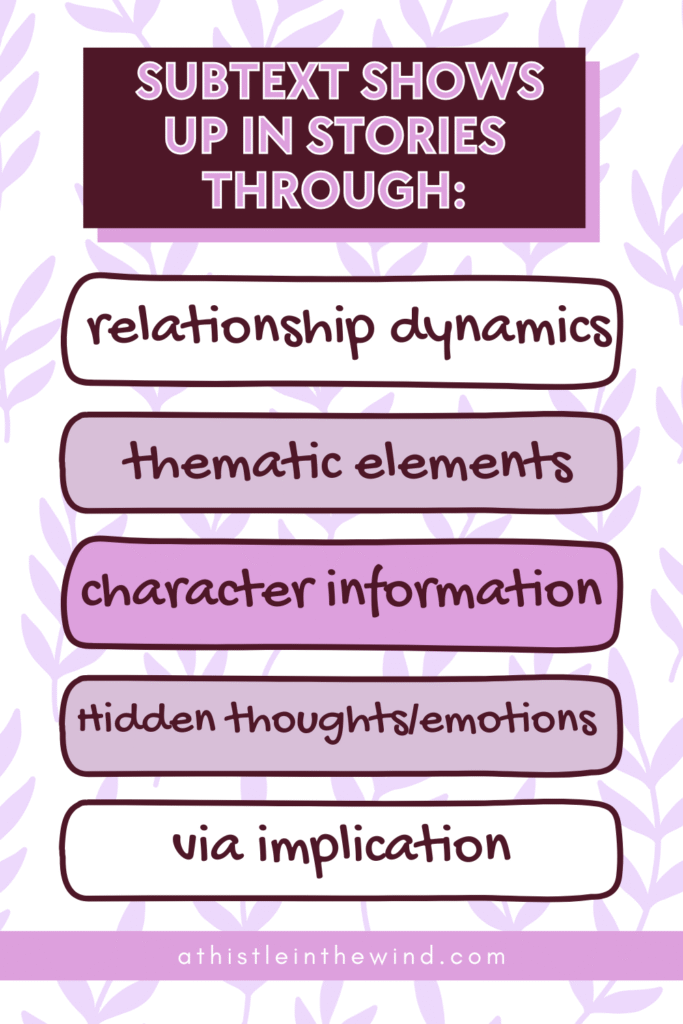
Let the Subtext Grow Organically
One of the most important things to understand about subtext is that it often emerges naturally, rather than being something you force into existence. This is why I think it’s important to have a clear idea of who your characters are and what their end goal is.
I’m not saying that you should have every detail of your story mapped out before you start writing, but it certainly helps if you know where your character or general plot is going. Why’s this important? Well, because then you as the writer have a better idea of what’s happening.
When I’m writing, I already have a detailed plan for my character, and that helps me add subtext into any scene (I think of them as easter eggs for readers to go: “why didn’t I see it earlier?”) that I’m working on.
Subtext is a bit similar to symbolism. If you’re too on-the-nose, you’re probably forcing it, making your writing feel awkward.
For your first draft, it’s often more productive to view it as a space for subtext to emerge organically.
Be observant and look out for it as you write, because it can often surface subconsciously, even to you as the writer. This has happened to me multiple times. This is why it’s a good idea to have multiple rounds of refinement after you’ve written your first draft.
Techniques for Writing Subtext in Dialogue
Now that you have an understanding of what subtext is, let’s get to the part where I actually help you add it to your story. So, in this section, we’re going to look at how you can add it to your dialogue.
If you’re interested in learning how to write better dialogues, check out: On Writing Dialogue: How to Write Better & Believable Lines.
Here’s how you can add subtext in your dialogue.
1. Give Your Characters Goals and Desires
As I mentioned earlier, compelling subtext in dialogue comes from your character’s goals and wants. Characters who lack desires have no reason to withhold information or tailor their behaviour or words.
But as soon as you give them something they truly want, the way they interact with the world will change. It can be simple too. Like, your housewife character could want an extra bottle from the milkman. Or, it can be as complex as your politician character speaking to members from the opposing party, convincing them to pass the bill they want.
Side Note: I’m watching the PDS this morning as I’m writing this. Lots of politics in today’s episode.
Your characters’ words and actions will shift depending on what they want in the scene. This can mean not saying certain things or saying things that aren’t completely true.
2. Let Your Characters Talk Around the Point
This one’s pretty good—if you do it right. Here’s how to think about it. Have you ever had to tell a loved one that you broke or lost something they really liked? Like, maybe you have a sister who’s obsessed with her stationery collection, and you took a sharpie or something and lost it. And it wasn’t just a sharpie, it was her favourite sharpie.
How do you break the news to her? Well, unless you’re completely tactless and want your sister to ban you from her things forever, you’re probably going to bring up the topic slowly.
Maybe talk about how it’s so easy to misplace things when you’re busy, how it’s probably somewhere in the house—you just don’t remember where, oremphasize how much of a scatterbrain you are, or perhaps, you’ll overcompensate and just buy her a new pack of sharpies.
This may or may not have happened before. And my sister is twenty-five, by the way.
But this is a great example of talking around the point. And often, when characters are in conflict, instead of having them directly address the issue, you can have them talk about something completely different.
What they’re talking about will then start to mirror the actual conflict, allowing them to say things without truly saying them.
This kind of dialogue is some of the most valuable stuff you can add to your story. Seriously, it can be humorous or it can significantly escalate the tension.
3. Reveal Information with Unspoken Implications
Think about how information revealed in one scene can subtly impact future interactions, even if it’s never explicitly acknowledged.
When you introduce a piece of information, consider how it will affect subsequent scenes, changing the dynamic between characters in unspoken ways.
For example, if one character shares a traumatic backstory that involves being taken advantage of, and another character in the scene is plotting to take advantage of someone else, that revealed backstory will sit between them in every future interaction.
The protagonist’s pursuit of the relationship might become darker, and the other character’s situation more tragic, without either character ever speaking of it again. The audience will remember this information and understand its unspoken effect on the relationship.
4. Utilise Contradictions
Contradictions are a powerful tool for delivering subtext. They create a dissonance that signals a deeper meaning to the audience.
- Body Language Versus Dialogue: A character might insist they are “fine,” but their eyes avoiding gaze or their fidgeting hands tell a different story. Body language provides a secondary meaning making your writing feel more alive. It can imply if the character is hiding something or if they’re not ready to articulate their true feelings. It can also foreshadow emotions before they are fully expressed in dialogue, or indicate a more or less intense version of what is being said.
- Speech Patterns Versus Normal Speech: When a character’s speech pattern deviates from their norm, it signals subtext. If a character who is usually calm and never interrupts suddenly snaps or rambles, it tells you something important about their underlying emotions or the significance of what they’re saying.
- Disproportionate Responses: A character’s reaction that seems out of proportion to the event—exploding in anger, breaking down, or being ecstatic when the situation doesn’t demand it—is a strong indicator of hidden subtext.
- Changing Roles/Patterns: If you have characters who play certain roles in conversations and they suddenly shift and begin acting differently? Well, that’s a clear subtext for a hidden change or motivation.
5. Subtle Agendas and Rewording
Characters can have different agendas in a scene, even if they’re not directly at odds. These subtle desires can create subtext without overt conflict.
For example, in a scene where characters are working together, one might simply want to get out of the rain, and this subtle agenda can influence their dialogue and actions.
Sometimes, the best way to create more subtext is not to add more conflict, but to reword and restructure the conversation that’s already there.
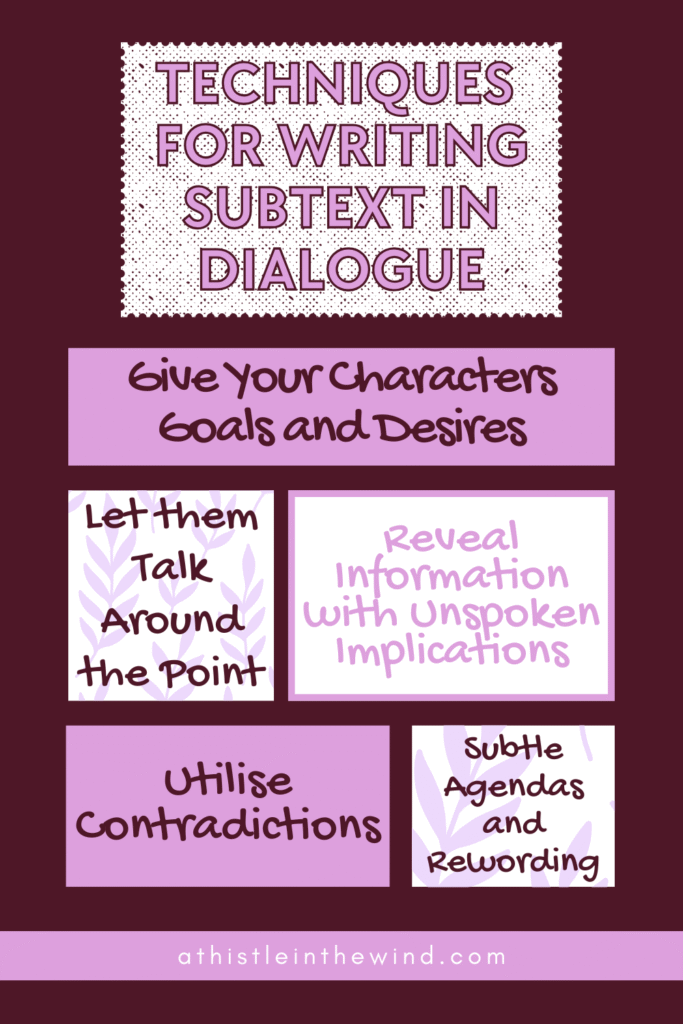
Writing Subtext Through Action and Description
As I said at the beginning of this blog, subtext goes beyond dialogue. Writers commonly use dialogue for this tool, but there are other ways to add richness to your writing via subtext.
1. Let Actions Speak
The old saying, “actions speak louder than words,” is particularly fitting when it comes to subtext. When words don’t quite capture a character’s true thoughts and feelings, their actions will.
- Gestures of Dominance or Power: Going back to our politician character, think about Frank Underwood from House of Cards. From the very first episode, we know that he’s an important guy. How? Well, it’s because of the way he interacts with the world around him. When he decides to take down the President, it’s his demeanour more than his words that tell us that he’s powerful, and that he’s going to do it.
- Symbolic Actions: In The Godfather, Kate’s simple act of closing a door on Michael signifies her literal and metaphorical shutting out of his new life, filled with his dark business.
- Contradictory Actions: A particularly rich source of subtext comes from actions that directly contradict dialogue. If a character tells themselves, “You stop drinking right now!” while simultaneously pouring another glass, the juxtaposition reveals a deep internal struggle or self-deception.
When writing subtext through actions, always ask yourself: Is there something a character can do to communicate their thoughts and feelings instead of relying solely on dialogue? This embodies the principle of the “show, don’t tell” philosophy.
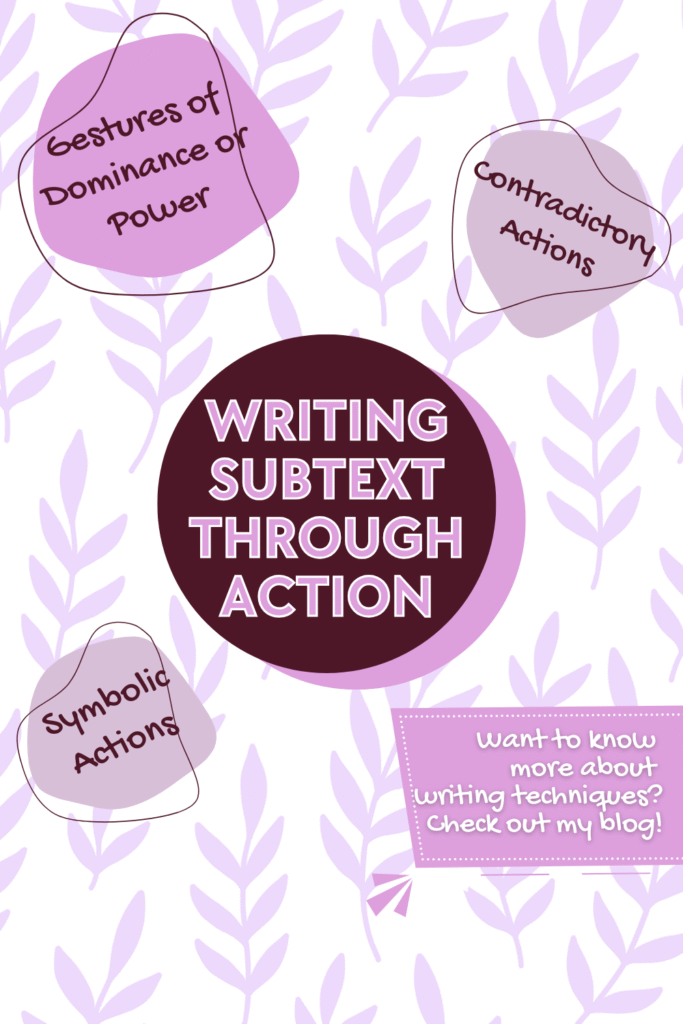
2. Descriptive Clues
You can describe a character’s internal conflict or an underlying tension through description. A powerful example of this is in Sound of Metal. A character’s habit of scratching her arm, established early in the story as a sign of self-harm, returns later as a subtle, yet devastating, indicator of her potential relapse into old, destructive patterns.
When another character notices this recurring action, it leads to a profound epiphany about their relationship, culminating in a simple, subtext-laden line, “It’s okay, Lou.”
These kinds of moments, added through description, make your writing more nuanced and emotionally impactful.
Finding the Right Balance: Subtext vs. Stating the Obvious
While subtext is truly wonderful and essential for adding depth, it’s vital to remember that not everything in your story needs to be subtextual.
Seriously, it’s so easy to fall into the trap of thinking that every feeling, emotion, desire, and yearning must be hidden beneath the surface. But this can actually make your subtext impossible for the reader to access.
Sometimes, explicit reflection is perfectly okay, and even necessary. You need to allow your characters to openly reflect on their wants, flaws, desires, and how they feel about things. This lets your readers feel closer to them, offering a direct window into their minds.
In fact, explicit reflection can even strengthen the subtext by providing a reference point. If the audience has no way to truly connect with the character’s core motivations, the subtext will lack impact.
Think of subtext as the “seasoning” of your story, not the “base”. The most important, key aspects of your story should be clearly stated on the page.
Subtext then serves as that extra layer of depth, drawing readers in and adding nuance to what’s already clear. And this is incredibly important.
If you fail to set up the base, you risk undermining your characters, and even the plot of your story, completely. Remember, your readers are intelligent. They can pick up on things if you allow them to. You don’t have to be extremely vague or spell out everything for them. It’s really a balancing act; and you can 100% master it.
If you’re interested in learning more about how you can make your writing better, check out my blog: On the Art of Pacing: A Writer’s Guide.
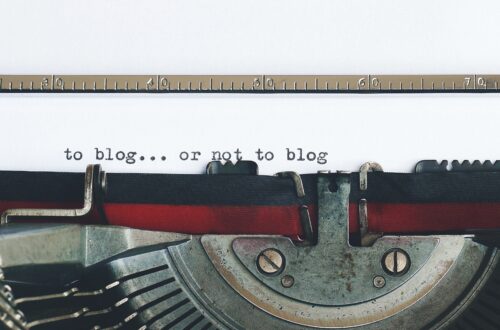
5 Comments
Serena
Sura,
Thank you for putting this article together. This information is truly insightful and a wonderful tool for any writer looking to utilize subtext in their novel. Bravo!
Sura
Thanks Serena! Your comment made my day:)
Kev
Can we get more details? I feel like there’s still a lot
Sura
Hi Kev! I completely agree with you! I’ll have more related blogs coming out in the next few weeks:)
Phillip Delson
Very insightful